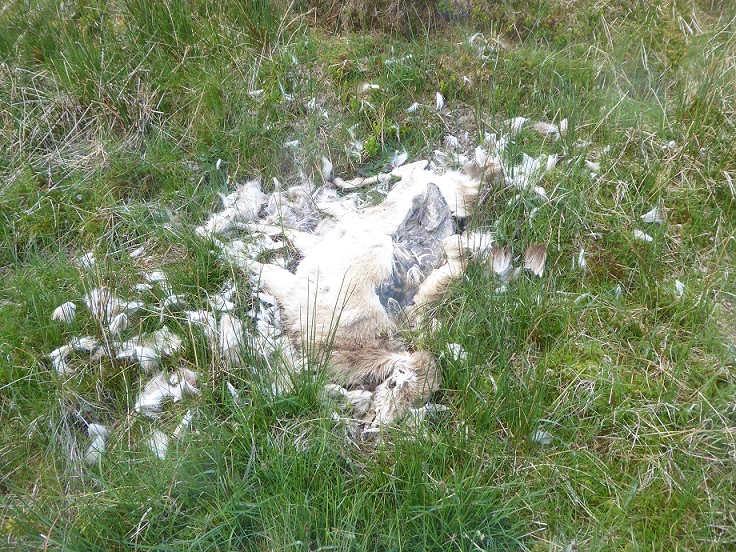 There is another side to the hullabaloo that the Scottish Gamekeepers Association (SGA) raised three weeks ago about a pregnant red deer hind that had been shot out of season on Skye (see here).
There is another side to the hullabaloo that the Scottish Gamekeepers Association (SGA) raised three weeks ago about a pregnant red deer hind that had been shot out of season on Skye (see here).
 Last week (see here), on the edge of the Fannichs, I saw and smelled more dead red deer than I have done for many a year.
Last week (see here), on the edge of the Fannichs, I saw and smelled more dead red deer than I have done for many a year.
Just round the corner from where we were camping, at an altitude of c.300m, there were eight red deer corpses at the bottom of a sheltered bank above the Dundonnell River. It appears they had taken shelter during the snow that closed the road last winter and either starved or frozen to death.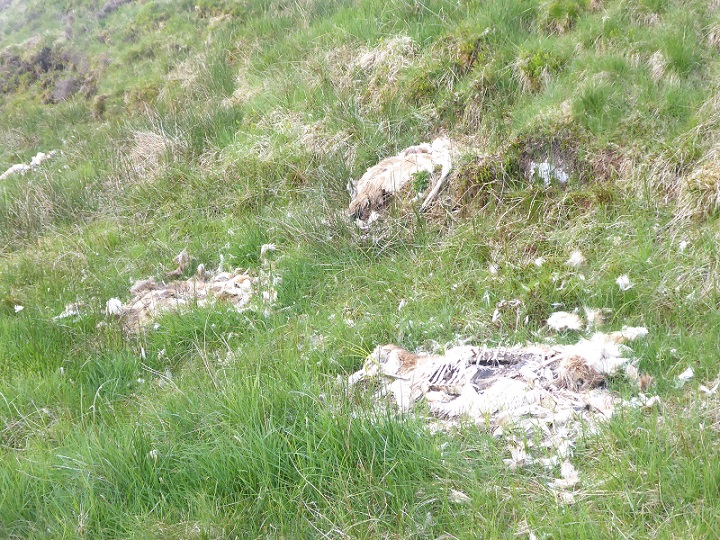
While there is good grazing along the river in summer, the red deer had nowhere left to go in winter, with much of the lower ground around Dundonnell fenced off and new native woodland plantations restricting their traditional grazing grounds still further.
So, which is worse, shooting a heavily pregnant deer or allowing the red deer population to rise to such levels that other hinds, some also no doubt pregnant, died like this? A false question which would disappear if Scotland had predators like wolves. There would then be no closed season and any deer not in prime condition would provide an easy meal.
It seems to me, however, that the Scottish Gamekeeper’s Association, in focusing attention on the hind that was shot on Skye, was distracting people from the wider issues.
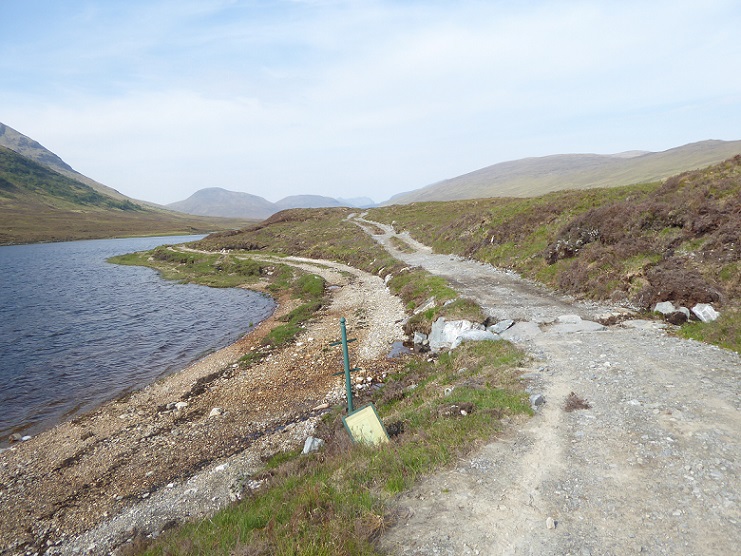
Just over the hill from the Dundonnell River, walking along one of the two tracks that now grace the north shore of Loch a’ Bhroan, we were met every few hundred metres with the stench from a decaying red deer corpse.
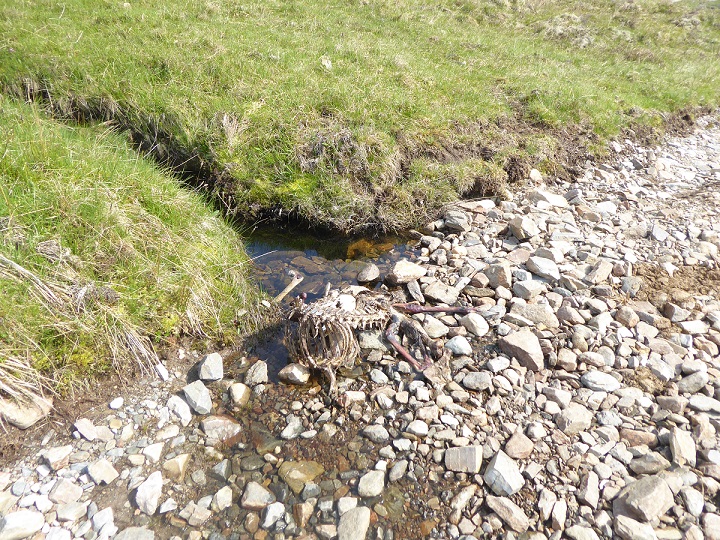
Never, in forty years of visiting the Highlands, have I felt less inclined to drink water from the local burns.
I encountered a similar stench along the road between Dundonnell and Corriehallie.
By all accounts there was a lot of snow in the north west this winter and the weather last year may have resulted in less grass surviving into the winter than usual. Both will have contributed to the death toll. But I saw plenty of other evidence to show that the red deer population in Fisherfield and the Fannichs is far too high and this is having a severe impact on biodiversity in the area.
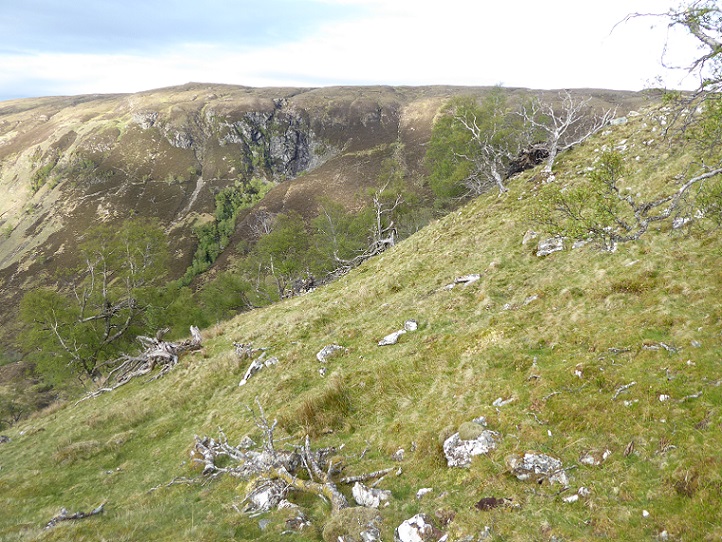
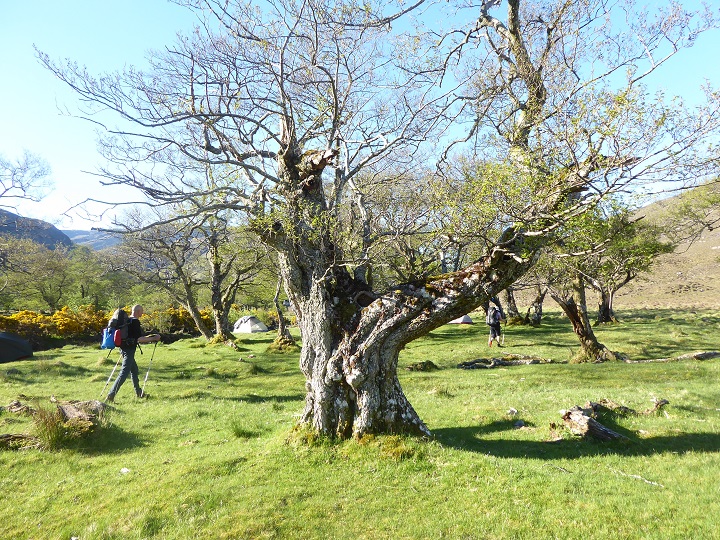
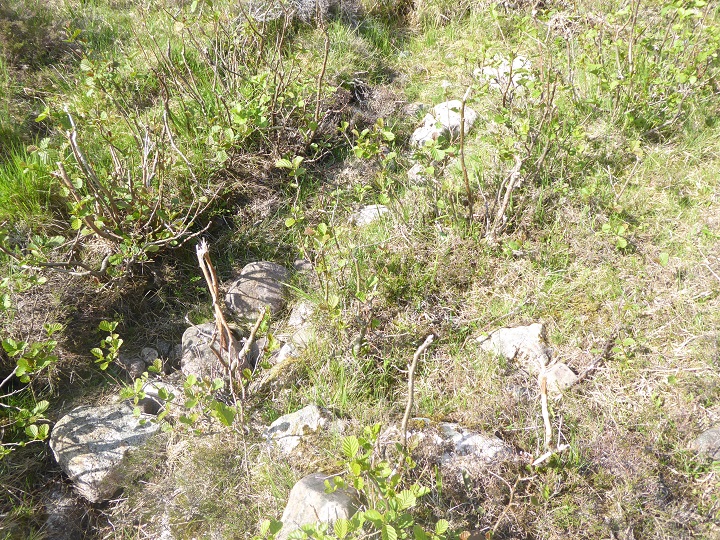

While claiming to be non-political, the SGA used the incident on Skye to argue that the Scottish Government should not extend the hind shooting season as recommended by the deer working group (to the start of April, not May). In doing so, they are playing the card of the landowners, who have consistently resisted any reduction in the numbers of red deer (not least because their estates are valued by the number of deer) and used welfare reasons (that its cruel to shoot deer at particular times of year) to help justify this.
Unfortunately NatureScot and Scotland’s two National Park Authorities, all of which should be dedicated to reducing red deer numbers in the interests of conservation, generally appear too feart to expose the hyprocrisy of the SGA or their landowning paymasters when it comes to their arguments about the welfare of red deer. Hence, in part, the sad evidence I saw on my trip to the north west and the reason for this blog.

These problems of deer overpopulation are widespread. Yesterday, in a trip up Glen Tilt in the southern Cairngorms, mile upon mile of overgrazed hillside was evident, with scraps of natural woodland restricted to narrow gullies and cliff faces. Atholl Estates have a massive over population of red deer and appear to have no answer to the problem. Further east, on Balmoral, there is a further demonstration of how not to manage upland Scotland in the face of a climate and biodiversity crisis. Until the Royal Family spend some time on Glenfeshie Estate and learn how to reduce deer populations down to levels which permit extensive natural regeneration of tree and shrub communities there is no hope. Continuing to manage land in the Cairngorms as though Queen Victoria is still on the throne is setting the worst possible example to other landowners in Scotland. Atholl and Balmoral and others need to wake up.
This has been going on for decades – I remember, for example, finding numerous carcases of red deer that had starved or frozen to death strewn around Fisherfield in the spring of 1966.
Fisherfield is one of the finest landscapes in Europe, and yet we allow it to be thrashed, and its vegetation eaten to the bone by grossly excessive deer numbers simply to suit the requirements of its sport shooting landowners. In addition, in more recent years, feral goats have greatly increased in numbers in this area. Goats can get to places – gorges and crags – that the deer can’t reach. So, even these small areas that have acted as the final refuge for native woodlands and flowers are now being devastated. The goats also eat the bark and thus kill even mature trees like holly and rowan that in a few places have survived the ravages of the deer.
I do not believe any other country in Europe would tolerate such wanton destruction of its natural heritage, and yet in Scotland over vast areas of the uplands it is the norm: and the Scottish Government and its agencies do almost nothing to change the situation, whilst decade after decade the destruction continues. It is so widespread that many folk think such devastation is somehow natural or inevitable, but the few places where steps have been taken to reverse this disgraceful history, such as Glen Feshie and Craig Meagaidh, amply demonstrate that that belief is false.
Of course, the landowners may claim that to reduce deer and goat numbers would be difficult and expensive – and, of course, that is correct. But in so doing they would be admitting that they have neither the will nor the means to ameliorate this situation. So the government of any country worthy of the name should take matters into its own hands: after seeing our finest lands trashed decade after decade by private landowners the time has surely come, indeed is long past, for such special areas to be taken into public ownership and managed for the benefit of the land, its nature and for the nation as a whole.
Will Scotland stand up and do what is right for such lands, or will we continue to tug our forelocks to whomsoever has the deepest pockets, irrespective of the devastation they bring to their landholdings?
The number of red deer that starved to death thus spring is shocking and something I’m surprised there has been complete silence on.
On the edge of the monadliath, where I live, 3 or 4 have been found within 500m of my house and the last couple that I shot (eating the last blades of grass in my fields) were just skin stretched over bone and had to be buried.
This is in an area where they have access to all the land they always have (including 100acres of ancient birchwood and thousands of acres of plantation) so being fenced out of the sheltered areas is not a factor here.
I’m sure it’s only the tip of the iceberg that we are seeing as most deer will find a sheltered hollow or dense forest to lie in before they die meaning that most corpses will not be obvious.
Even now in June I’m still seeing a lot more deer coming into the low ground fields to feed that I ever remember seeing before. I assume that this means the survivors are still struggling in the hills.
The total lack of any coverage of this in the media, given how widespread the issue appears to be, makes me think the issue is deliberately being swept under the carpet.
Not happy with the outcome at any point, but don’t believe controls on Deer numbers is the answer, large animals have always migrated, they naturally move pastures because of diseases etc. Fencing and roads with no thought to this issue is the problem. Farming uses medication to allow animals to stay in one area. Need a major rethink about nature as a whole, not silly projects which later cause problems.
Did you not read the article. We have a massive overpopulation of deer. They need to be controlled and where the numbers are controlled everyone wins.
There was an article in the Scottish Field or similar 20 years ago about a pilot scheme in Glen Kingie on Etiveside where they carried out a severe pruning of the deer herd and the result was an increase in the size of those left over and no loss of deer to shoot as they all breed successfully.
Deer, like Pheasants, Sheep, and Grouse are a plague that needs cured.
This post reminds me of a walk I took what must be 30 years ago in a long remote glen in Perthshire. It was at the end of Winter and the place stunk over 2 or 3 km in distance of rotting deer carcasses- many were in watercourses where drifted snow was melting, revealing their bodies. When people argue about the cruelty of controlling deer numbers I am always reminded of this. I have witnessed it several times since, though not on the same scale. I also recall standing on a ridge in the same area that is now in the CNP looking over to an 800 metre high hill with a pap like top. I couldn’t understand what I was seeing. I thought it was some sort of landslide as the whole top section of the hill was moving downwards. I then realised it was deer- so many (hundreds) that there were virtually obscuring the contours of the hill. Quite a sight, but I wondered how many would end up starving to death in a snow bank the following Winter.
After all the reports, inquiries, and public bodies set up to manage this natural resource over the past 60 years or so, we still have the same issues, neatly described here, as we’ve always had. Indeed arguably they have got worse. The SGA are an obstacle to progress, as are the landowners and agents. Quite why anyone has taken any notice of them for so long goodness only knows. NatureScot, SNH, DCS and RDC over the years have all failed massively to tackle the vested interests and latterly not without the support of ministers and parliamentarians some of whom have asked if the Public Body itself is not part of the problem…it is. Look at the Caenlochan S7. How many years? The owners are simply running circles around NatureScot. Endless ‘increased culls’ chasing deer from pillar to post untll the behaviour changes and the deer form one massive herd. Less cruel would be a substantial ‘step-wise’ reduction to a sustainable figure carried out over a few days by many professional stalkers. If this means taking out a third or more of the current population, then so be it.
This permanant review and monitor and survey etc. is such a waste of resource.
Remember the hysteria when they did that on Mar Lodge? we had nonsense about deer being shot from helicopters and other bollocks from the SGA and their supporters.
It is just another example of the cowardice of our elected representatives that they refuse to take on a handful of parasites when the health of the Scottish environment and the welfare of about 500,000 Deer is at stake.
Think you’re referring to the knicker-twist as a result of the request from Glenfeshie to SNH for help with a reduction cull to protect the pinewood SAC. And look at Glenfeshie now.
It does however seem to be completely okay with SGA and others for the expirtation of red deer if the objective is a red grouse monoculture. Funny that.
Oh and yes, red deer reproduction changes with a reduction in the population, more and better stags are produced and more gross young in better condition are also produced, which makes this business of increasing a ‘traditional cull’ number to achieve a reduction means that stalkers have to run faster in each successive year to keep still. And when you think about it, over a given period, more deer will be killed in this approach to achieve the same end than if a ‘one-off’ stepwise significant reduction cull was to take place. Again, quite why anyone takes notice of the SGA is beyond me.